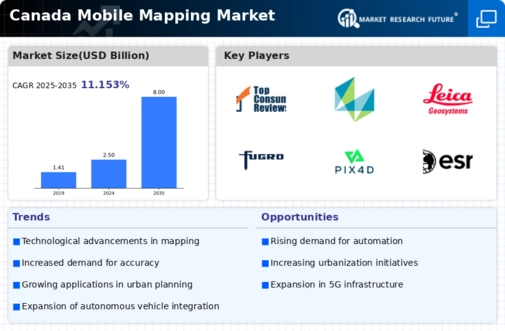Increased Focus on Asset Management
Asset management is becoming a focal point for various sectors in Canada, including transportation, utilities, and telecommunications. The mobile mapping market is benefiting from this trend as organizations seek to optimize their asset management strategies through accurate spatial data. By utilizing mobile mapping technologies, companies can efficiently monitor and manage their assets, leading to reduced operational costs and improved service delivery. The Canadian government has recognized the importance of effective asset management, implementing policies that encourage the adoption of innovative technologies. This shift is expected to propel the mobile mapping market forward, with projections indicating a growth rate of approximately 8% as more organizations invest in these solutions.
Integration of Advanced Technologies
The integration of advanced technologies such as LiDAR, GPS, and photogrammetry is transforming the mobile mapping market in Canada. These technologies enhance the accuracy and efficiency of data collection, making it easier for businesses and government agencies to obtain precise geographical information. For instance, LiDAR systems can capture millions of data points per second, allowing for detailed 3D modeling of landscapes. This technological evolution is likely to attract more stakeholders to the mobile mapping market, as organizations seek to leverage these innovations for improved decision-making and operational efficiency. The market is expected to see a compound annual growth rate (CAGR) of approximately 12% as these technologies become more accessible and affordable.
Rising Demand for Smart City Initiatives
The push towards smart city initiatives in Canada is significantly impacting the mobile mapping market. As municipalities aim to enhance urban living through technology, the need for comprehensive mapping solutions becomes increasingly critical. Mobile mapping technologies provide essential data for traffic management, public safety, and urban planning, aligning with the goals of smart city projects. The Canadian government has allocated substantial funding for smart city initiatives, which is likely to drive the mobile mapping market forward. With an estimated investment of $50 million in smart city projects, the market could see a notable increase in demand for mobile mapping services, potentially leading to a growth rate of around 10% over the next few years.
Growing Demand for Infrastructure Development
The mobile mapping market in Canada is experiencing a surge in demand driven by the ongoing infrastructure development projects across the nation. With the Canadian government investing approximately $180 billion in infrastructure over the next decade, the need for accurate mapping solutions becomes paramount. Mobile mapping technologies facilitate the collection of high-resolution spatial data, which is essential for planning and executing construction projects. This demand is further fueled by the necessity for real-time data to ensure compliance with safety regulations and environmental standards. As urban areas expand and rural infrastructure is upgraded, the mobile mapping market is poised to benefit significantly from these investments, potentially leading to a market growth rate of around 15% annually in the coming years.
Emerging Applications in Environmental Studies
The mobile mapping market in Canada is witnessing emerging applications in environmental studies, driven by the increasing need for sustainable practices. Organizations are utilizing mobile mapping technologies to conduct environmental assessments, monitor natural resources, and manage land use effectively. This trend aligns with Canada's commitment to environmental conservation and sustainable development. The mobile mapping market is likely to see growth as more entities recognize the value of accurate mapping in environmental decision-making. With government initiatives promoting environmental sustainability, the market could experience a growth rate of around 9% as demand for these applications rises.



















Leave a Comment